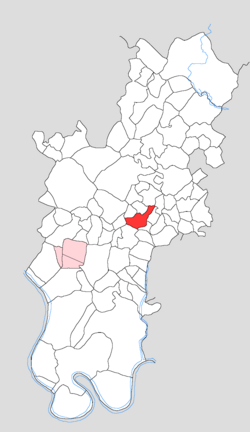| This article needs additional citations for verification. Please help improve this article by adding citations to reliable sources. Unsourced material may be challenged and removed. Find sources: "Jarkhi" – news · newspapers · books · scholar · JSTOR (July 2021) (Learn how and when to remove this message) |
Village in Uttar Pradesh, India
| Jarkhi | |
|---|---|
| Village | |
 Map showing Jarkhi in Tundla block Map showing Jarkhi in Tundla block | |
 | |
| Coordinates: 27°14′32″N 78°17′53″E / 27.24222°N 78.29811°E / 27.24222; 78.29811 | |
| Country | India |
| State | Uttar Pradesh |
| District | Firozabad |
| Tehsil | Tundla |
| Area | |
| • Total | 2.518 km (0.972 sq mi) |
| Population | |
| • Total | 1,468 |
| • Density | 580/km (1,500/sq mi) |
| Time zone | UTC+5:30 (IST) |
Jarkhi (Jārkhī) is a village in Tundla block of Firozabad district, Uttar Pradesh. As of 2011, it has a population of 1,468, in 262 households. Jarkhi was historically the capital of a taluqdari estate held by a Jat family and comprising 41 villages. It was also known for its prosperous Jain community and its export trade in shoes and ghee.
Geography
Jarkhi is located about 6.5 km northeast from Tundla, the tehsil headquarters. The Jhirna, a small rain-fed stream that historically marked the boundary between Itimadpur and Firozabad tehsils, flows past Jarkhi.
History
Jarkhi was historically the seat of a large taluqdari estate, which originated in 1803 with a lease of 41 villages granted to two Jats named Sundar and Dalip Singh. (Or, according to another version, to a Jat moneylender from Mahaban named Dheri Singh; in the first version, he is described as Dalip Singh's grandson.) Previously, Jarkhi had been held by a different group of Jats. Dheri Singh and his descendants later fell into debt and had to sell or mortgage much of their property to biswadars or sub-proprietors. They later settled with the biswadars and bought back proprietorship, and at the turn of the 20th century there were several branches of the family who held a combined total of 56 villages. The main family residence in Jarkhi at that point consisted of a group of masonry buildings surrounded by an earth wall and a deep ditch.
Jarkhi at the turn of the 20th century was described as a busy market village that held markets twice per week. Shoes were manufactured here and many were exported for sale in Calcutta (now Kolkata), and there was also a large export of ghee to Firozabad and Shikohabad. Fruit was also exported to Agra when in season. The village also had an upper primary school, a post office, and a stud farm. As of 1901, Jarkhi's population was 1,362, including a significant minority of 321 Jains. Jarkhi's Jain community was wealthy and prosperous and had built "a fine temple" in the village.
Demographics
As of 2011, Jarkhi had a population of 1,468, in 262 households. This population was 54.4% male (798) and 45.6% female (670). The 0-6 age group numbered 207 (104 male and 103 female), making up 14.1% of the total population. 360 residents were members of Scheduled Castes, or 24.5% of the total.
The 1981 census recorded Jarkhi as having a population of 1,022 people (565 male and 457 female), in 177 households and 165 physical houses.
The 1961 census recorded Jarkhi (as "Jakhi") as comprising 1 hamlet, with a total population of 951 people (521 male and 430 female), in 140 households and 137 physical houses. The area of the village was given as 625 acres and it had a post office and medical practitioner at the time.
Infrastructure
As of 2011, Jarkhi had 1 primary school and 1 medical clinic. Drinking water was provided by hand pump and tube well/borehole; there were no public toilets. The village had a sub post office but no public library; there was at least some access to electricity for all purposes. Streets were made of both kachcha and pakka materials.
References
- ^ "Census of India 2011: Uttar Pradesh District Census Handbook - Firozabad, Part A (Village and Town Directory)" (PDF). Census of India. Retrieved 19 June 2023.
- ^ Nevill, H. R., ed. (1905). Agra: A Gazetteer, Being Volume VIII of the District Gazetteers of the United Provinces of Agra and Oudh. Allahabad: Government Press. Retrieved 18 November 2023.
- "Census of India 2011: Uttar Pradesh District Census Handbook - Firozabad, Part B (Village and Town Wise Primary Census Abstract)" (PDF). Census of India. Retrieved 19 June 2023.
- Census 1981 Uttar Pradesh: District Census Handbook Part XIII-A: Village & Town Directory, District Agra (PDF). 1982. Retrieved 25 July 2023.
- Census 1961: District Census Handbook, Uttar Pradesh (22 - Agra District) (PDF). Lucknow. 1965. Retrieved 25 December 2021.
{{cite book}}: CS1 maint: location missing publisher (link)
This Firozabad district location article is a stub. You can help Misplaced Pages by expanding it. |